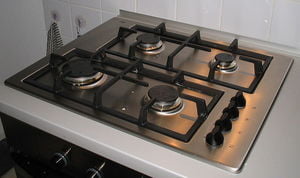Gong green in the kitchen begins with making intelligent choices about energy use. It’s a great start to use eco friendly lighting, but installing an eco-friendly stove will go even farther towards reducing your carbon footprint. For this reason, many people choose induction cooktops. Understanding this energy efficient stove begins with learning how induction cooking works.
Traditional Stoves: Long Cooking Times
On a traditional stovetop, either a gas powered flame or an electrically heated coil transfers energy to a container like a pot or pan. For the eco-friendly chef, one drawback to this approach is that heat is only transferred to the container where the heat source touches it. This means longer cooking times and more energy used to prepare your food.
Limited heat transfer is also troublesome for the gourmet chef. If you’ve ever experienced the frustration of continually stirring a delicate sauce prepared on the stove, only to have it still wind up scorched or burned in places, you’ll appreciate the way an induction cooktop can effectively solve this problem.
Traditional Stoves: Wasted Heat
The other major drawback of the traditional stove is that between the heat source and the container, a large amount of heat energy escapes into the surrounding air. This means in addition to using far more electricity or gas than is actually needed to cook your food, you’ll use even more energy for air conditioning later. An eco-friendly stove uses induction to minimize the heat wasted energy escaping as heat.
How Induction Cooking Works: Eco-Friendly Electromagnetism
Rather than using an external heat source, an induction cooktop turns the container itself into the heating element which cooks food. Put simply, induction cooking works by using the same principles of electromagnetism behind a maglev train to induce a current in your cookware.
Beneath the induction cooktop’s surface, a coil of copper wire carries a current. This current through the coil of wire produces a magnetic field, which is transferred into the pan. The magnetic field in the pan then induces a current through the pan’s molecules, which in turn generate smaller magnetic fields of their own. Soon, every molecule of the container is vibrating and colliding against adjacent molecules, and the resultant friction causes heat.
The result of the magnetic induction process is more even heat distribution throughout your cookware, and less wasted energy from heat escaping into the surrounding air.
Induction Stoves: Benefits and Drawbacks
Because of how induction cooking works, one potential drawback is that you’ll only be able to use “ferrous” cookware. If you don’t already own steel or cast-iron pots and pans, this will be an additional investment to consider upon making your initial stove purchase. Fortunately, good cast-iron or steel cookware is durable and will last a long time.
Also, since the induction cooktop itself acts only to generate a magnetic field rather than acting as a heating element, it remains relatively cool to the touch. Not only does this add to the energy efficient stove’s safety, it makes spills easier to clean since they won’t bake onto a heat source.
When choosing an eco-friendly stove, you’ll want something that doesn’t create an overabundance of wasted heat, but maintains the flexibility and cooking precision a gas range can offer. A dial varying the strength of the induction cooktop’s magnetic field reacts instantly, so adjusting the temperature is simple.
The Eco-Friendly Kitchen Choice
There’s a lot you can do to go green in the kitchen, and making intelligent choices about your appliances is a great start. Understanding how induction cooking works can help you choose a more energy efficient stove. The planet will thank you, and your food will be great, too.
References:
“Induction Cooking: How it Works” www.theinductionsite.com
Gerbis, Nicholas. “How Induction Cooktops Work” www.HowStuffWorks.com
“How Induction Works — Two Part Cooking System” www.GEappliances.com


